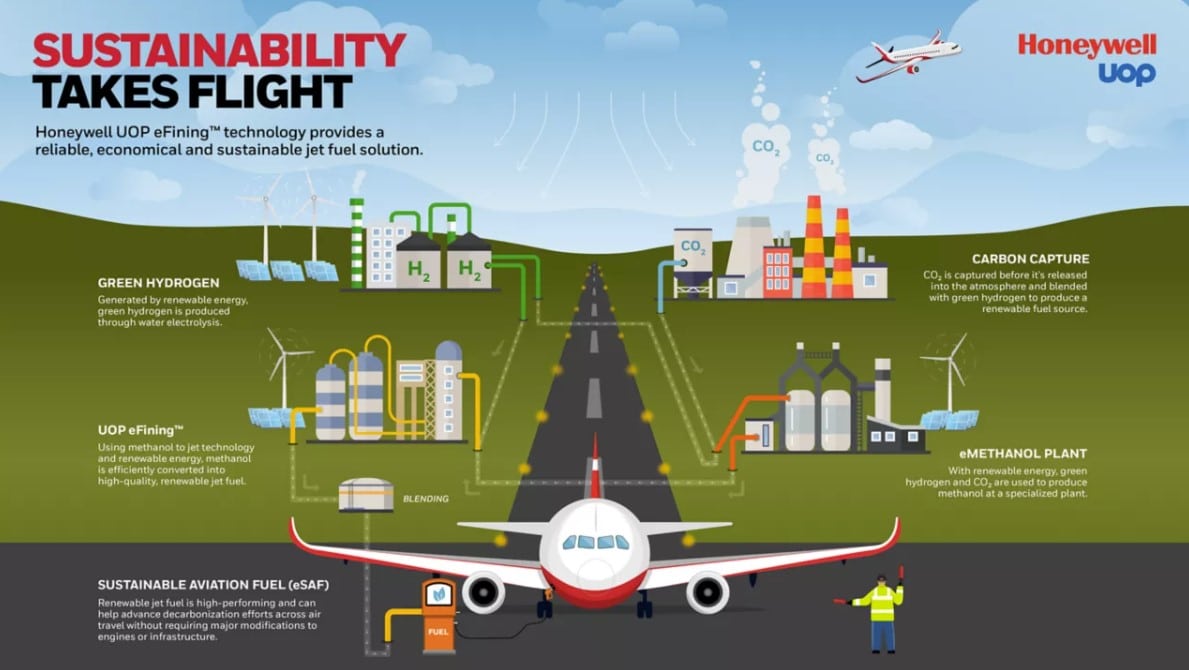Global production of sustainable aviation fuel (SAF) is forecasted for a 30-fold increase by 2030, according to a recent report by US-based sustainability analytics group cCarbon. Today, SAF represents under 1% of the jet fuel market but the International Air Transport Association (IATA) approved a resolution for the global air transport industry to achieve net-zero carbon emissions by 2050. Honeywell has been a pioneer of SAF processing technology and has set the pace in SAF technology development and commercial fabrication for years.
As of June 2022, IATA projects 23 billion liters of SAF will be needed by 2030, accounting for 5.2% of the total fuel requirement. (Source: S&P Global). By 2050, SAF production will need to hit 449 billion liters, about 65% of the total fuel requirement. This accelerates the need for alternative SAF feedstocks to meet demand. (Source: IATA).
Honeywell has designed their Ecofining solution that aims at facilitating SAF development, Willie Coetzee, Market Development Director at Honeywell Europe explained to DirectIndustry in an interview.

Can you give more details on the Ecofining solution and how it facilitates SAF development?
Willie Coetzee: “Honeywell helped pioneer sustainable aviation fuel (SAF) production with its Ecofining™ process, which has been used to produce SAF commercially since 2016. Developed in conjunction with Eni SpA, it converts non-edible natural oils, animal fats, and other waste feedstocks to renewable fuels like diesel (HVO – hydrogenated vegetable oil) and SAF. Honeywell Ecofining™ is a proven technology that has been used around the world for years. It produces SAF, which helps reduce GHG emissions by up to 80% when compared to the emissions from fossil fuels.*
Honeywell’s SAF has shown higher energy density in flight, which allows aircraft to fly further on less fuel, meets or exceeds critical jet fuel specifications, such as flash point, freeze point, stability, and heat of combustion, and is a drop-in replacement fuel that requires no changes to aircraft technology or fuel infrastructure. SAF currently can be used in blends of up to 50% with the remainder as conventional (fossil-based) jet fuel.
As of June 2023, Honeywell has sold 36 Ecofining™ licenses covering approximately 420 KBPD of capacity in the U.S., Europe, Asia, Australia, and South America. Worldwide, 7 commercial plants in operation use the Ecofining™ process, with a total capacity of 1.1 billion gallons/year of feed processed. These customer units that utilize Honeywell’s technology result in very nearly 1 billion gallons/year of distillate products (renewable diesel + renewable jet).”


Honeywell recently announced doubling the number of licenses for its SAF technology. Could you elaborate on the factors behind this increase?
Willie Coetzee: “Rising demand for such solutions prompted a jump in EcofiningTM licenses issued between 2016 and 2021, with 12 of those 36 licenses being issued in the past two years, and we continue to expand the use of Ecofining™ around the world.
In France, Total Energies will create a bio-refinery to process 400,000 tons of feed per year, producing up to 170,000 tons of SAF, 120,000 tons of renewable diesel, and 50,000 tons of renewable naphtha for the production of bioplastics. This project will increase renewable jet fuel production in France and convert Total’s Grandpuits refinery into a zero-crude platform that supports government plans to develop fossil fuel substitutes and achieve carbon neutrality.
In Japan, Honeywell is working with JGC Holdings and Cosmo Oil on the first commercial-scale SAF project in Japan. The companies are using Honeywell UOP Ecofining™ technology to convert locally sourced used cooking oil into renewable jet fuel meeting ASTM D7566 standards with start-up scheduled in 2025.”

BP has implemented the Ecofining solution. Could you provide some details on the outcomes achieved so far through this collaboration?
Willie Coetzee: “At the end of May, BP announced it is installing Honeywell’s Ecofining™ process at five plants across the world including locations in EU and U.S: Cherry Point refinery in Blaine, Washington; Rotterdam II refinery in Rotterdam, Netherlands; Lingen refinery in Lower Saxony, Germany; Castellón de la Plana refinery in Castellón, Spain and Kwinana Oil refinery in Kwinana, Australia. The world’s demand for SAF is set to increase dramatically and BP seeks to play an important role in helping the airlines to decarbonize. Altogether, the installations increase BP’s SAF production from renewable feeds to help the company achieve its aim to supply 20% of the SAF market globally by 2030.”

Given that the SAF market is currently small, how can solutions like Ecofining contribute to its growth and significance in the industry?
Willie Coetzee: “Due to the global drive towards sustainability, forecasted demand for Sustainable Aviation Fuel is projected to reach 10 million barrels per day by 2050. The “Fit for 55” proposal in the EU requires aviation fuel to include eSAF at 5% by 2030 and 63% by 2050. The U.S. Department of Energy is targeting 3 billion gallons of SAF by 2030 and 35 billion by 2050. There is currently no commercial-scale production of SAF by eFuels pathways today, but Honeywell UOP eFining™ solves that problem by providing a viable pathway from CO2 to SAF, by implementing a combination of ready-now, large-scale, and commercially proven technology.”

What are the factors currently slowing down the development of SAF?
Willie Coetzee: “There are multiple factors to consider in terms of the pace of adoption of SAF, including supply-side factors, policy, incentives, and market demand. Many of these factors are currently converging. As a leader in renewable fuel technology, Honeywell recognizes that creating technologies that use new feedstocks is vital to the long-term decarbonization of the aviation sector. The ability to use readily abundant CO2 to produce SAF is for instance a transformational opportunity for this market.


Is Honeywell involved in any projects related to the development of SAF through Carbon Capture, Utilization, and Storage (CCUS)?
Willie Coetzee: “Honeywell UOP eFining™ is the latest technology in a line of offerings that are driving the decarbonization of the aviation sector. It uses methanol produced from captured carbon dioxide (CO₂) and green hydrogen (which is made from water and renewable electricity) to produce eSAF.
eFuels, also known as electro fuels, are a class of synthetic fuels that can replace conventionally produced fossil fuels. eFuels combine green hydrogen (i.e., hydrogen produced in electrolysers from renewable energy and water) and carbon dioxide (CO2) to produce eMethanol, which can then be converted to a wide range of sustainable fuels, including eSAF, eGasoline, and eDiesel. The technology is efficient, resulting in high yield eSAF production at a lower cost relative to comparable technologies. Honeywell UOP eFining can reduce greenhouse gas (GHG) emissions by 88% compared to conventional jet fuel. When blended with conventional jet fuel at up to 50%, eSAF is a drop-in replacement fuel that requires no changes to aircraft technology or fuel infrastructure.
Honeywell UOP eFining™ technology will be deployed by HIF Global at its second U.S. eFuels operation. The project represents the world’s largest eSAF production facility. HIF’s eSAF facility using Honeywell’s eFining™ process is projected to recycle approximately 2 million tons of CO2 to make 11,000 barrels per day of eSAF.”
The ability to use readily abundant CO2 to produce SAF is a transformational opportunity for this market, adding to the available feedstocks used in SAF production. To date, Honeywell has developed capabilities for processing four different feedstocks into SAF: CO2, Fats, oils, and greases (FOG) (already in market), woody biomass- Alder/United Investment (in development) and Ethanol (Honeywell’s Ethanol-to-Jet process announced Oct. 2022).“

How does Honeywell envision the SAF market evolving for the company in the current year and the next five years?
Willie Coetzee: “Market demand for Honeywell’s Ecofining technology has been very strong. Over the next decade or so, we see supply of fats, oils, and greases saturating. This is one of the reasons that Honeywell has invested in bringing to market solutions that are ready to be implemented at scale and would allow our customers to convert feedstocks such as Ethanol and CO2 to SAF. Honeywell also continues to develop our woody biomass to jet technology and see it playing a role in future. Market side demand to our customers has steadily picked up over the last years and we see increasing interest from airport and airline operators in SAF, as was evident by the engagements we had with these stakeholders at the Paris Air Show. Over the next five years we see a significant expansion in on stream units, as our sold licenses are converted to installed capacity. Additionally, we have already announced projects applying our ETJ and eFining technologies, and we hope to see the first of these large-scale units coming to fruiting in the 5-year timeframe. In the long term our aerospace business expects industry to move to new disruptive technology for shorter distance travel, however, sees a long-term need for SAF in wide bodies, long haul flights, which represents roughly 1/3rd of current Jet demand.”
*GHG reductions are based on LCA analyses conducted at Michigan Technological University under the direction of Dr. David Shonnard.










